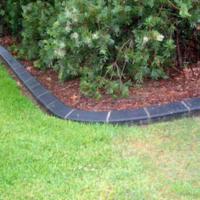Basic Concepts: Line and Form for Landscaping
by Dan Eskelson on Apr 29, 2012
This will be the first in a series exploring the fundamental design principles used in the creation of landscapes; many of these concepts are common to other forms of creative expression - painting, sculpture, and music...the art of landscape design seeks to create a functional, unified and aesthetically pleasing outdoor environment.
Other creative elements employed in landscape design include color, texture, scale, symmetry, proportion, rhythm, and repetition; all are dependent on each other and must be considered together to produce a unified design. Unlike most art forms, seasonal and long-term changes in form, color, and other elements must be considered. The line is created in the landscape by existing patterns of structures, hardscapes, planting beds, and plant material. Line influences how the eye moves through the landscape - horizontally along walks and planting beds and vertically up and down plant forms and structures. The line is also created by individual plant shapes (i.e. branches, leaves) and how various plant shapes are arranged.
Straight lines are perceived as formal ad structural; curved lines are perceived as natural and relaxing. Straight lines will lead the eye more directly to a point than curved lines. Thus, the line will influence the "mood" of the landscape and should be considered with the overall intent or theme; the vast majority of new landscapes utilize more curved lines to offset the very structured elements of architecture - and the very structured quality of modern life! Closely related to the concept of line is form, which may relate to an individual plant, or the arrangement of plants in the landscape. Plants are classified as upright, columnar, spreading, weeping, pyramidal, round, etc. - a plant grouping may also be described using these terms.
The form of structures should also be considered, as well as the relationship between this form and the form of adjacent plants. Forms may complement or contrast; we may use tall, columnar plant forms around a building with very steep, projecting roof lines to complement the architecture. Or it may be desired to contrast these vertical architectural elements with low, spreading forms. There are no strict rules for the use of form, but it's important to consider the effects that form exerts on the total landscape design.
Again, remember that plant forms change over time; the specific purpose of a form should be considered in terms of mature size; though the landscape may seem sparse at first, growth will produce the desired effect. Examples of over-planted landscapes are common; to achieve a "finished" look, too many plants are installed, resulting eventually in a congested, unappealing landscape. We'll continue this discussion of the basic concepts of landscape design in the next issue; if you have any questions or comments, feel free to contact me.
Popular Articles
Three Places to Spend Money on the Exterior of Your Home
When you have the exterior of your home remodeled, you are investing, time, energy and convenience into the project and you want to make sure that...
95796 Views
Homemade Headboards-Make an Upholstered or Wooden Headboard
Homemade headboards can add a lot of personality to any bedroom. They can be coordinated with existing furniture and room decor or they can be the...
74455 Views
When to Use a Brush, Roller or Sponge Brush
Brushes are a good choice for painting trim and woodwork. They are also useful for cutting in the edges around the top and bottom edges and corners...
71821 Views
Creating a Cottage Kitchen with Bead Board
Kitchen decor can range from modern and bold to elegant and elaborate by using strategic kitchen pieces. One of the most popular decorating trends...
52899 Views
Gas Fireplace Diagnostics and Troubleshooting
Follow these steps for diagnosing and troubleshooting Gas Fireplaces repairs. For the average DIYer, this may seem intimidating, depending on the...
30639 Views
Latest Articles
How Much Does It Cost To Take A Bath?
Plumbers know that a bath may seem like a relaxing luxury, but the real cost extends far beyond your water bill. The average soak uses 35 to 50...
on Apr 8, 2025
10 Concrete Patio Ideas on a Budget
A concrete patio can be a game-changer for your outdoor space. It is durable, versatile, and can be customized to fit your style. But what if you...
on Mar 25, 2025
Tips for Creating a Stunning Personalized Photo on Canvas
Order the unique beauty of a personalized photo on canvas and bring your memories to life. With a customized photo on canvas, you can transform...
on Mar 7, 2025
Best Areas to Buy Property in Singapore for Long-Term Growth
Singapore's real estate market remains one of the most stable and lucrative in the world. With limited land supply, strong governmental...
on Feb 18, 2025
Troubleshooting Excess Water in Your HVAC Secondary Condensate Drain Pan
When maintaining your air conditioning system, it is easy to overlook the condensate drain pan - until excess water starts pooling in places where...
on Jan 12, 2025
Featured Articles
What Type of Licensed Contractor Should You Hire?
on Feb 28, 2017
Hire Contractors / Estimates

Looking for a specialty project? There are many types of contractors available for your home improvement needs. Finding the right type of...
Sponsored Articles
Best Areas to Buy Property in Singapore for Long-Term Growth
on Feb 18, 2025
Real Estate / Finance

Singapore's real estate market remains one of the most stable and lucrative in the world. With limited land supply, strong governmental...
Actions
Top Categories
- Garden / Landscaping / Patio — 264
- Kitchen / Bathrooms — 240
- Real Estate / Finance — 203
- Appliance / Repair — 186
- Interior Design / Decor — 184
- HVAC / Air Conditioning — 148
- Cleaning / Maintenance — 144
- Improvements / Remodeling — 131
- Plumbing / Basements — 118
- Floors / Tile / Hardwood — 116
- Doors / Garages — 113
- Safety / Security — 113
Articles Archive
More DIY Articles
Solutions for 3 Common Apartment Design Problems
When you live in an apartment, your ability to correct design and decorating problems is limited. From obvious issues to the design problems,...
Top Tips For Successfully Using Augers In Your Garden
An auger is a perfect way to make a hole and can be used for a variety of different things. For example, an auger is used to create a borehole,...
Tools to Repack Wheel Bearings
Wheel bearings carry the weight of a car, while at the same time ensuring that wheels run smoothly. All too often, they are neglected and...
7 Decor Tips to Make Your Home Look Luxurious
Your home is your sanctuary. And it should look as luxurious as you want to feel. There are tons of ways you can make your home luxurious without...
How Large can I Build a Structure in my Backyard?
If you are really asking how big you can build without having to worry about permits and paperwork, that is a different issue than having an...

